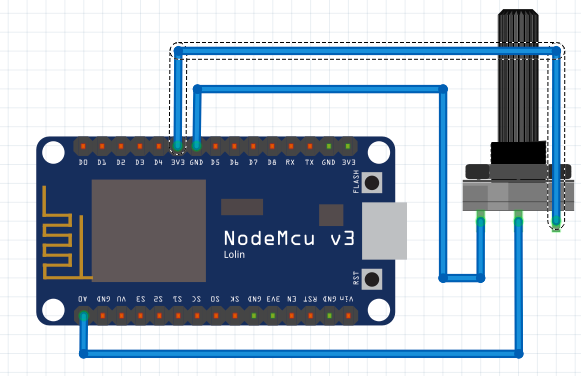Nowadays I’m involved with a cloud project based on SAP Cloud Platform (SCP). Side projects are the best way to mastering new technologies (at least for me) so I want to build something with SCP and my Arduino stuff. SCP comes whit one IoT module. In fact every cloud platforms have, in one way or another, one IoT module (Amazon, Azure, …). With SCP the IoT module it’s just a Hana Database where we can push our IoT values and we’re able to retrieve information via oData (the common way in SAP world).
It’s pretty straightforward to configure the IoT module with the SAP Cloud Platform Cockpit (Every thing can be done with a hana trial account).
NodeMcu
First I’m going to use a simple circuit with my NodeMcu connected to my wifi network. The prototype is a potentiometer connected to the analog input. I normally use this this circuit because I can change the value just changing the potentiometer wheel. I know it’s not very usefull, but we can easily change it and use a sensor (temperature, humidity, light, …)

It will send the percentage (from 0 to 100) of the position of the potentiometer directly to the cloud.
#include <ESP8266WiFi.h>
const int potentiometerPin = 0;
// Wifi configuration
const char* ssid = "my-wifi-ssid";
const char* password = "my-wifi-password";
// SAP SCP specific configuration
const char* host = "mytenant.hanatrial.ondemand.com";
String device_id = "my-device-ide";
String message_type_id = "my-device-type-id";
String oauth_token = "my-oauth-token";
String url = "https://[mytenant].hanatrial.ondemand.com/com.sap.iotservices.mms/v1/api/http/data/" + device_id;
const int httpsPort = 443;
WiFiClientSecure clientTLS;
void wifiConnect() {
Serial.println();
Serial.print("Connecting to ");
Serial.println(ssid);
WiFi.begin(ssid, password);
while (WiFi.status() != WL_CONNECTED) {
delay(500);
Serial.print(".");
}
Serial.println("");
Serial.print("WiFi connected.");
Serial.print("IP address: ");
Serial.println(WiFi.localIP());
}
void sendMessage(int value) {
String payload = "{\"mode\":\"async\", \"messageType\":\"" + message_type_id + "\", \"messages\":[{\"value\": " + (String) value + "}]}";
Serial.print("connecting to ");
Serial.println(host);
if (!clientTLS.connect(host, httpsPort)) {
Serial.println("connection failed");
return;
}
Serial.print("requesting payload: ");
Serial.println(url);
clientTLS.print(String("POST ") + url + " HTTP/1.0\r\n" +
"Host: " + host + "\r\n" +
"Content-Type: application/json;charset=utf-8\r\n" +
"Authorization: Bearer " + oauth_token + "\r\n" +
"Content-Length: " + payload.length() + "\r\n\r\n" +
payload + "\r\n\r\n");
Serial.println("request sent");
Serial.println("reply was:");
while (clientTLS.connected()) {
String line = clientTLS.readStringUntil('\n');
Serial.println(line);
}
}
void setup() {
Serial.begin(9600);
wifiConnect();
delay(10);
}
int mem;
void loop() {
int value = ((analogRead(potentiometerPin) * 100) / 1010);
if (value < (mem - 1) or value > (mem + 1)) {
sendMessage(value);
Serial.println(value);
mem = value;
}
delay(200);
}
SCP
SAP Cloud Platform allows us to create web applications using SAPUI5 framework easily. It also allows us to create a destination (the way that SAP’s cloud uses to connect different modules) to our IoT module. Also every Hana table can be accessed via oData so and we can retrieve the information easily within SAPIUI5.
onAfterRendering: function () {
var model = this.model;
this.getView().getModel().read("/my-hana-table-odata-uri", {
urlParameters: {
$top: 1,
$orderby: "G_CREATED desc"
},
success: function (oData) {
model.setProperty("/value", oData.results[0].C_VALUE);
}
});
}
and display in a view
<mvc:View controllerName="gonzalo123.iot.controller.Main" xmlns:html="http://www.w3.org/1999/xhtml" xmlns:mvc="sap.ui.core.mvc"
displayBlock="true" xmlns="sap.m">
<App>
<pages>
<Page title="{i18n>title}">
<content>
<GenericTile class="sapUiTinyMarginBegin sapUiTinyMarginTop tileLayout" header="nodemcu" frameType="OneByOne">
<tileContent>
<TileContent unit="%">
<content>
<NumericContent value="{view>/value}" icon="sap-icon://line-charts"/>
</content>
</TileContent>
</tileContent>
</GenericTile>
</content>
</Page>
</pages>
</App>
</mvc:View>
Cloud Foundry
The web application (with SCP and SAPUI5) can access to IoT values via oData. We can fetch data again and again, but that’s not cool. We want real time updates in the web application. So we need WebSockets. SCP IoT module allows us to use WebSockets to put information, but not get updates (afaik. Let me know if I’m wrong). We also can connect our IoT to an existing MQTT server, but in this prototype I only want to use websockets. So we’re going to create a simple WebSocket server with node and socket.io. This server will be listening to devices updates (again and again with a setInterval function via oData) and when it detects a change it will emit a broadcast to the WebSocket.
SAP’s SCP also allows us to create services with Cloud Foundry. So we’ll create our nodejs server there.
var http = require('http'),
io = require('socket.io'),
request = require('request'),
auth = "Basic " + new Buffer(process.env.USER + ":" + process.env.PASS).toString("base64"),
url = process.env.IOT_ODATA,
INTERVAL = process.env.INTERVAL,
socket,
value;
server = http.createServer();
server.listen(process.env.PORT || 3000);
socket = io.listen(server);
setInterval(function () {
request.get({
url: url,
headers: {
"Authorization": auth,
"Accept": "application/json"
}
}, function (error, response, body) {
var newValue = JSON.parse(body).d.results[0].C_VALUE;
if (value !== newValue) {
value = newValue;
socket.sockets.emit('value', value);
}
});
}, INTERVAL);
And that’s all. My NodeMcu device connected to the cloud.
Full project available in my github

